| |
|
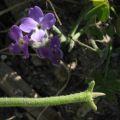 | |
| MaltaWildPlants.com by Stephen Mifsud |

|
| |
|
|
 |  |  |  |
| External Links: |
|
Anchusa italica (Italian Bugloss) |

Anchusa italica (BORAGINACEAE.)
Images for this profile are taken from the Maltese Islands after year 2000. |
|
| Nomenclature |
Species name : | Anchusa italica Retzi. | Authority : | Anders Jahan Retzius, Sweden, (1742 - 1821) | Synonyms :
(basionym or principal syn.) |
|
Plant Family : | | English name(s) : | Italian Bugloss, Large Blue alkanet, Garden Anchusa | Maltese name(s) : | Lsien il-Fart ikħal | Status for Malta : | Indigenous. Present on the Maltese islands before man | Name Derivation : |
Anchusa: Comes from the Greek word referring to a delicate paint used on the face (similar use to nowadays' make-up) alluding to a particular red dye extracted from the roots of this plant. Such a name was already used by Aristofanes and Xenofon, (400 BC) for the name this plant. (Greek origin ); 2 = Comes from the Greek word meaning "face make-up paint" since of a particular red dye extracted from the roots. Such a name was already by Aristofanes and Xenofon, (400 BC) for the name of a plant (Greek);.
italica: originating from or related to Italy, for example described first from Italy. (Latin origin ); 2 = Italian origin or related to Italy (Latin).
| Remarks : | |
|
| Morphology and structure |
PLANT STRUCTURE: |
Character | Growth Form | Branching | Surface |
Description | | | |
General
Picture |  |  | 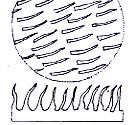 |
|
LEAVES: |
Character | Arrangement | Attachment | Venation |
Description | | | |
General
Picture |  |  |  |
| |
Character | Leaf Shape | Leaf Margin | Remarks |
Description | | | |
General
Picture |  |  |  |
|
FLOWERS: |
Character | Colour | Basic Flower Type | No. of Petals | No. of Sepals |
Description | Blue | | 5 | 5 |
General
Picture | | 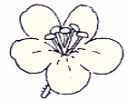 |  |  |
| |
Character | Inflorescence | Description | Ovary | Stamens |
Description | | The flower consists of 5 free sepals, and 5 petals fused at their base to form a tube-like structure, but they become separated into 5 distinct petals forming a flat faced corolla. The center is white due to the presence of a brush of white bristles which covers completely the 5 stamens and single pistil inside. | | |
General
Picture |  |  | 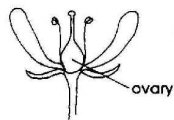 | 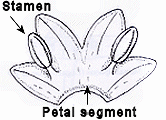 |
| |
Character | Scent | Average Flower Size | Pollen Colour | Other Notes |
Description | None | 12-14 | Pale yellow | - |
|
SEEDS: |
Character | No. Per Fruit | Shape | Size | Colour |
Description | 4 | Tooth-shaped Cylindrical with one end flat and attached in sockets in the receptacle and the apical end being rounded or pointed. They have a hard wrinkled texture. | 6mm x 4mm (L x W). | Black Seeds on the plant are usually still pre-mature and have a dark green colour. |
General
Picture |  |  |  |  |
|
FRUIT AND OTHER BOTANICAL DATA: |
Character | Fruit Type | Colour of Fruit | Subterranean Parts | Other Notes |
Description | | Light Brown | | Bristles The bristles covering almost all the plant are white, stiff but not spiny, down growing, and about 2 or even 3 mm in length. When dry, they can become hard and sharp. |
General
Picture | 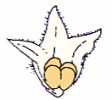 |  |  |  |
|
|
| Plant description and characters | |
Life Cycle: | Perennial. |
Growth Form: | HEMICRYPTOPHYTE (prostate plants with flowers close to the ground) |
Habitat: | Sides and perimeter tracks of arable fields, roadsides and sideways on stony hills, especially if beside cultivated fields. |
Frequency: | Scarce |
Localities in Malta: | Besides or inside some fields at Dingli, Buskett and Rabat (Mtarfa area). |
Plant Height: | 30-150cm. |
| Apr-Jun |
Protection in Malta: | Not legally protected till the last update of this website (2/Mar/2022) |
Red List 1989: | Not listed in the Red Data Book of the Maltese Islands |
Poison: | |
The Large Blue alkanet is one of the tallest species of the Anchusa genus, reaching up to 150 cm, but usually in Malta it stays low about 80cm. The plant is well branched, especially at the flowering part, which produces flowers in panicles. The stem is usually green but can get a purple/brown tinge. It is entirely covered with numerous white bristles which are stiff but not spiny, and about 2mm to 3mm long.
The leaves varies in size, with the basal leaves reaching 25cm in length and the upper leaves found at the flowering part are just few centimetres long. The shape is however maintained in all leaves and it is generally lanceolate - more elongated in the basal leaves. They are sessile, alternately arranged on the stem and grow at an acute (small) angle with the axis of the stem. The leaves are covered with white stiff bristles and so they resemble oxen tongue for which this name is given in some countries for this plant (eg: Oxtungor "oxen tongue" in Sweden)
The plant produces a large number of flowers having a characteristic bright blue colour, sometimes with little violet tinge, also described as electric blue colour. They are made up of a polysepalous (free sepals) calyx and sympetalous (fused petals) corolla. The petals are joined at their base forming a tube like structure, and then they separate as 5, free, roundish petals forming a corolla with a flat face. Such a shape is described as salverform. The center of the flower is white, due to the presence of clusters of fine white hair or bristles which are so dense that they completely cover the stamens at the centre. There are 5 stamens with black anthers that produce pale yellow pollen, and filaments which are fused with the basal part of the corolla tube. The filaments project out from the wall by few mm just under the anther. The pistil consists of a central, inferior ovary, and a simple style+stigma reaching approximately the same level of the stamens.
When the corolla falls off, the style and stigma remains protruding from the calyx (from the small ovary inside) for several days. The fruit is borne on the receptacle as 4 small nutlets which are rarely seen since covered by the long sepals of the calyx. When developed. the seeds are bullet shaped, with a wrinkled texture, black (or dark green) in colour and 6-7mm long. Usually they drop off to the ground prematurely and continue to ripen on the ground. There is no specific disperssion method.
|
|
| Information, uses and other details |
Nativity
The plant is Native throughout whole Europe, especially the southern and central parts (eg: Sicily, Italy, Greece, Hungary, Romania, France Portugal Spain, Ukraine, and also Russia) It is also found in Western Asia (Iraq, Pakistan, Israel, Cyprus, Turkey, etc), Caucasus (eg: Azerbaijan, Soviet Middle Asia: Kazakhistan etc.), and Tropical Asia (eg: Pakistan). [WWW-26] It is believed to be originated from the Mediterranean areas from Portugal and east to the Caucasus [WWW-65]
Edible Uses
Raw Flowers are an excellent and decorative addition to the salad bowl, or used as a garnish [183] .
The tender young leaves and young flowering shoots can be cooked and eaten as a vegetable [7] .
In Tunisia, the young leaves were used to be mixed with those of wild sorrel and eaten in soup. [WWW-33]
Medicinal Uses
The plant has the following medicinal properties: [7] .
| Antitussive |
used to suppress or relieve coughing. [WWW-32]
|
| Depurative |
An agent which is able of Purifying the blood or the humors (body fluids) [WWW-32] |
| Diaphoretic |
A medicine or agent which promotes perspiration. [WWW-32] |
| Diuretic |
Tending to increase the secretion and discharge of urine. [WWW-32] |
| Poultice |
A soft composition, as of bread, bran, or a mucilaginous substance, to be applied to sores, inflamed parts of the body, etc. so as to relief them. [WWW-57] |
The whole plant is antitussive, depurative, diaphoretic and diuretic. It is harvested when in flower and dried for later use. The dried and powdered herb is used as a poultice to treat inflammations. Use internally with caution, the plant contains the alkaloid cynoglossine which can have a paralysing effect [7] and carcinogenic [WWW-05] .
Other Uses
A red dye is obtained from the root. This was at one time used as a basis for some cosmetics [7] . The flowers are a good source of food for bees [1] . Many named forms have been selected for their ornamental value [187] . The plants tend to be short-lived perennials but they can be propagated by means of root cuttings [187] .
Though Alkanet imparts a fine deep red colour to oily substances and to spirit of wine, it tinges water with a dull brownish hue. Wax tinged with Alkanet, and applied to the surface of warm marble, stains it flesh-colour and sinks deep into the stone. It is also used in colouring spurious 'port-wine,' for which purpose it is perfectly harmless. [WWW-03]
Propagation Details
Seeds can be sown in a greenhouse or frame in March (in Jan-Feb in Malta [SM] ) in flats filled with sifted compost consisting of two-thirds loam and one-third leaf mold with sand added. They can also be started outdoors in a finely prepared seedbed as soon as the soil is suitable for sowing seeds in the spring. When the seedlings are an inch or so high, they should be set 3 inches apart in flats filled with similar soil. They are grown in a cold frame until they're large enough to plant outside. As soon as the seedlings that were started outside are an inch or two high, they should be set 9 inches apart in rows and finally planted in the fall or spring 21/2 feet apart. Root cuttings can be taken at planting time in autumn or early spring. Pieces of root that are 2 inches or so long, are placed end up (the part of the root that was nearest the stem being uppermost), 2 inches apart in boxes of soil and placed in a greenhouse having a 50-degree F temperature. [WWW-43]
The bottom of root should be cut slanting. When roots and leaves have developed, they should be potted individually in 3-inch pots, kept in a cold frame for the winter, and planted outside in the spring. [WWW-43] The seed usually germinates in 1 - 4 weeks at 21°C [133] .
Anchusa thrive in regular garden soil that is well drained and they need a sunny spot to grow in. The perennial kinds may be planted in early fall or spring. They are beautiful plants to grow in the herbaceous border. In soil that has adequate drainage, perennial Anchusa will live for several years, but in heavy land they usually die in the winter, therefore it's smart to raise new plants every year from root cuttings or seeds. In all gardens it's wise to raise a fresh supply every year or two to keep a stock of vigourous, healthy plants. [WWW-43]
History and traditional uses
The fresh root of all the Anchusa species (often called Alkanet) were used either as a red dye or in ointments for external use in treating wounds and burns. [WWW-03]
Parkinson says that the French ladies of his day coloured their faces with an ointment containing anchusa and the colour did not last long. [WWW-03]
Culpepper says:
'It is an herb under the dominion of Venus, and indeed one of her darlings, though somewhat hard to come by. It helps old ulcers, hot inflammations, burnings by common fire and St. Anthony's fire . . . for these uses your best way is to make it into an ointment also if you make a vinegar of it, as you make a vinegar of roses, it helps the morphy and leprosy . . . it helps the yellow jaundice, spleen, and gravel in the kidneys. Dioscorides saith, it helps such as are bitten by venomous beasts, whether it be taken inwardly or applied to the wound, nay, he saith further, if any that hath newly eaten it do but spit into the mouth of a serpent, the serpent instantly dies.... It also kills worms. Its decoction made in wine and drank, strengthens the back, and easeth the pains thereof. It helps bruises and falls, and is as gallant a remedy to drive out the smallpox and measles as any is; an ointment made of it is excellent for green wounds, pricks or thrusts.' [WWW-03]
Personal Observations
Useless to cut the fllowers for a vase
A small note for those who may want to cut some flowers to place in a vase at home. It is true that the unique bright blue flowers are attractive and tempting to cut and take home, but unfortunately after cutting, the plant (and especially) the flowers dies off, withen 12 hours or less. So it is a useless thing to pick some flowers of this plant. A good challenge will be to find some seeds and plant them at home. They are quite easy to plant (propagation details above). [SM]
How to collect the seeds
The seeds of this plant, like several species of the Borage family are difficult to locate and collect. The flower forms 4 nutlets covered by the 5 long sepals of the calyx, which make them not much visible. What's worse is that the seeds usually falls prematurely, and when examining the plant one would not find any ripe seeds present.
Despite this, a small percentage of seeds will remain attached on the plant. Since it is very time consuming to check the fruit one by one, you can use a large sheet of paper (eg newspaper or magazine), put it under a flowering branch, shake the branch vigourously (without damaging it), and collect the falling seeds in the paper below. Leave the seeds to dry well in the sun before sowing. [SM]
|
|
| Links & Further literature
(0 papers) |

Google Web |

Google Images |

Google Scholar |

Research Gate |

Wikipedia |

JSTOR |

GBIF |

Med Checklist |

Cat. of Life |

EoL |

IPNI |

World Flora Online |

Plants of the World Online |

Vienna Virt. Herb. |

RBGE Herbarium |

KEW Herbarium |

MNHN |

Arkive |

IUCN |

CABI |
Kindly Email if there are papers and publications about local
studies or information about this species to be included in the list above.
|
| Photo Gallery (27 Images) | 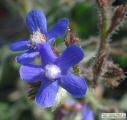 |
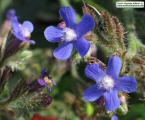 |
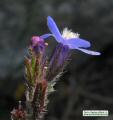 |
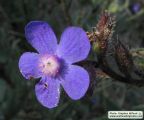 |
IMAGE: ANHIT-01 Photo of the bright blue flowers with white centres. |
IMAGE: ANHIT-02 Photo of 2 flowers in situ. |
IMAGE: ANHIT-03 Photo of lateral view of flower, showing that the white centre is made up of a brush of white bristles. The flower is a flat sympetalous (fused petals) which is also referred to as salverform. |
IMAGE: ANHIT-04 Close up photo of flower. This one has its central white bristles tinged with violet. |
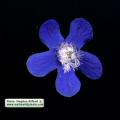 |
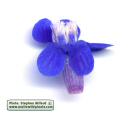 |
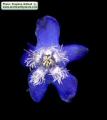 |
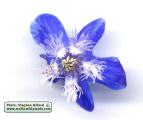 |
IMAGE: ANHIT-05 Scanned image of flower (front view). |
IMAGE: ANHIT-06 Scanned image of flower (lateral view). Note the small blue flaps supporting the cluster of bristles so that the stay in place. |
IMAGE: ANHIT-07 Scanned image of flower against a dark background, with petals folded back to expose the stamens hidden in the cluster of bristles. |
IMAGE: ANHIT-08 Scanned and magnified image of flower with exposed stamens. There are 5 stamens grouped together at the centre and usually hidden inside the white cluster of bristles. |
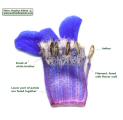 |
 |
 |
 |
IMAGE: ANHIT-09 Annotated scanned image of a dissected flower. The pistil is not included. It clearly shows that the basal part of the petals are fused, and that the stamens' filaments are adjoined with the flower wall and projects out only by few mm just under the anther. |
IMAGE: ANHIT-10 Scanned image of dissected flower showing the anthers, which are black and produce pale yellow pollen. The pistil, which consists of an inferior ovary, and a single and simple pistil is (not included). |
IMAGE: ANHIT-11 Scanned image of flower (lateral view) to show the calyx. It is made up of 5 free, long, hairy sepals which seem to have a purple outline. |
IMAGE: ANHIT-12 Photo of young fruit, which are not visible since they are covered by the long sepals of the calyx. Fruit consists of 4 ovate nutlets. |
 |
 |
 |
 |
IMAGE: ANHIT-13 Scanned image of uppermost part of a flowering branch which is hairy with several young buds. Before blooming, buds have a violet colour. When the blue corolla falls, the style and stigma persists for several more days. |
IMAGE: ANHIT-14 Scanned image of flower branch. The inflorescence consists branched panicles. |
IMAGE: ANHIT-15 Magnified scanned image of stem, covered with plenty of stiff but not spiny white bristles. The bristles are about 2-3mm long and grows downwards (hirstute). |
IMAGE: ANHIT-16 Scanned and annotated image of plant. |
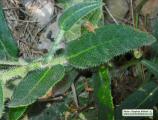 |
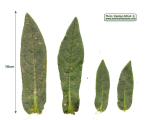 |
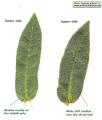 |
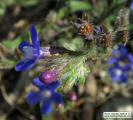 |
IMAGE: ANHIT-17 Photo of lance-shaped leaves covered with numerous white bristles. Because of the shape and bristles of leaves, some countries call this plant as ox-tongue. |
IMAGE: ANHIT-18 Scanned image of young and adult (basal) leaves. |
IMAGE: ANHIT-19 Scanned image of 2 leaves showing their under and upper face. Note that there are much more bristles in the upper face, whereas in the lower one bristles are limited to the midrib and few at the tip / edge of the leaf. |
IMAGE: ANHIT-20 Photo of bud which is violet and turns blue when the flower is blooming. |
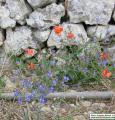 |
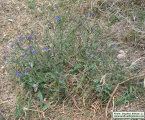 |
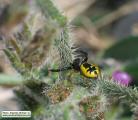 |
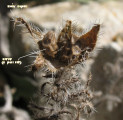 |
IMAGE: ANHIT-21 Photo of plant in its habitat; here being beside a stone wall in a road. Behind the stone wall there are cultivated fields. |
IMAGE: ANHIT-22 Photo of plant in a harvested field in late May. |
IMAGE: ANHIT-23 Photo of a spider found on this plant. It stays hidden under the flower and thanks to its long front legs it captures prey which land on the flower. |
IMAGE: ANHIT-24 Photo of fruit bearing the 4 wrinkled nutlets. No mechanical seed dispersion mechanism is involved, nutlets simply fall off to the ground. |
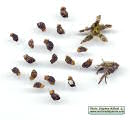 |
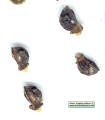 |
 |
| IMAGE: ANHIT-25 Scanned image of fruit which is made up of the 5 finger like sepals protecting the 4 nutlets held in 'sockets' on the receptacle. Also shown in the image are the dark green-black nutlets. |
IMAGE: ANHIT-26 Magnified scanned image of seeds which are roughly bullet-shaped nutlets with a plug-like shape at their base by which the seed is held in the receptacle socket. The seeds have a wrinkled seed-coat and are hard. |
IMAGE: ANHIT-27 Magnified image of pollen under microscope. They are spherical (or radially symmetrical) in shape. Taken from Flora apistica della Sicilia (by Prof. Nunzio Longhitano). |
IMAGE: ANHIT-28 |
|
| | |

